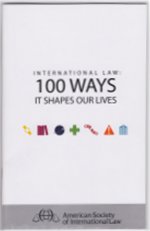100 Ways
International Law: One Hundred Ways It Shapes Our Lives
 By: James G. Apple, Editor-in-Chief, International
Judicial Monitor, and President, International Judicial Academy.
By: James G. Apple, Editor-in-Chief, International
Judicial Monitor, and President, International Judicial Academy.
ALWAYS KNOWING WHAT DATE AND TIME IT IS ANYWHERE ON THE PLANET(#1)
(In celebration of the 100th anniversary of the founding of the American Society of International Law in 2006, the Society published a small pamphlet titled International Law: One Hundred Ways It Shapes Our Lives. The Introduction gives an explanation for its conception: an affirmation that “international law not only exists, but also penetrates much more deeply and broadly into everyday life than the people it affects may generally appreciate.” This column seeks to elucidate and elaborate on many of the 100 ways briefly presented in the ASIL pamphlet.)
Probably the single most important characteristic of the frenetic society in which we all live is concern for time. Time rules almost all events of importance in our lives, of which there are seemingly an ever increasing number. Concern for time rules in government and politics, in cultural life, in war and peace, even in academic life, and also in international affairs. We all live in an impatient world, governed by concerns for time.
The world society is able to function as it does, with the burden of concerns for time always present, only because of the universal ability of an citizen in any country to know not only the current date and day of the week, but also the time at any place in the world. What makes all of this possible is international law.
The key “time” for creating the international system for time and date is October 1, 1884. That was the occasion for the convening of a month-long international meridian conference in Washington, D.C. Then U.S. President Chester A. Arthur called for the conference to make some sense of the different time/date systems then in use around the world for navigation and commercial purposes.
Before the 19th century, the most common method of establishing time (and thus also date) was the use of some type of instrument to determine the sun’s zenith, which takes place at noon each day. In 1769 an Englishman, John Harrison, showed how a clock could be used to determine accurately longitude at sea, a problem that had faced mariners for many centuries. This allowed navigators to determine precisely a ship’s position. This discovery was valuable to mariners and maritime companies, but it did not resolve the issue of a meridian that all nations of the world would recognize. What was needed was universal recognition of a “prime” meridian located in a specific place on earth and with it, universal recognition of a definition of a “day” or 24 hour period of time.
The most desired and used meridian for mariners and maritime companies was the one located at the Royal Observatory in Greenwich, England. An Englishman named George Airy had established it there in 1851. By 1884 over two-thirds of all shipping in the world, most of which was British, used the Greenwich Meridian to calculate needed dates, times and positions of ships. It formed the basis for the most reliable navigation data, which was the data published by the Royal Observatory. Other countries, however, used other meridians for maritime purposes, such as the one located in Paris, France.
Another Englishman, Sir Sandford Fleming, who worked to develop a world wide system of time keeping, promoted the idea of an international conference to establish a universally recognized prime meridian and an agreement on what constituted a day. His efforts gave impetus for President Arthur to call the “International Conference for the Purpose of Fixing a Prime Meridian and a Universal Day” on October 1, 1884, in Washington, D.C. On that date 41 delegates from 25 countries gathered to accomplish that purpose. Admiral C.R.P. Rodgers, one of the delegates representing the United States, was elected President of the Conference.
The major principles adopted at the conference through resolutions, were as follows:
- It is desirable to adopt a single prime meridian for all nations, in
place of the multiplicity of initial meridians that then existed.
- The meridian that passed through the center of the transit instrument at
the Observatory at Greenwich should be the initial meridian for longitude.
- All longitude would be calculated both east and west from the Greenwich
Meridian up to 180 degrees, east longitude being plus and west longitude being
minus.
- All countries should adopt a universal day.
- The universal day would be a Mean Solar Day, beginning for all of the
world at the moment of mean midnight at the initial meridian, coinciding with
the civil day and date at that meridian and to be counted from zero to 24
hours.
- Nautical and astronomical days everywhere in the world would begin at mean
midnight.
- All technical studies to regulate and extend the application of the decimal system to divide time and space should be supported.
The resolution establishing the Prime Meridian at Greenwich was not supported by all of the delegates. One nation, Santo Domingo, now the Dominican Republic, voted against the resolution. France and Brazil abstained. The French did not adopt the Greenwich Prime Meridian until 1911.
Since the 1884 conference the principles adopted at the international conference have come to be recognized by all the nations of the world.
The Greenwich Prime
Meridian came into the modern world on December 16, 1999. Prior to that date
first a brass strip and then a stainless steel strip in the courtyard of the
Royal Observatory at Greenwich had marked the Prime Meridian. On that date, very near the
beginning of a new century and a new millennium, it began to be marked also by
a “powerful green laser shining north across the London night sky.”

 International
Judicial Monitor
International
Judicial Monitor